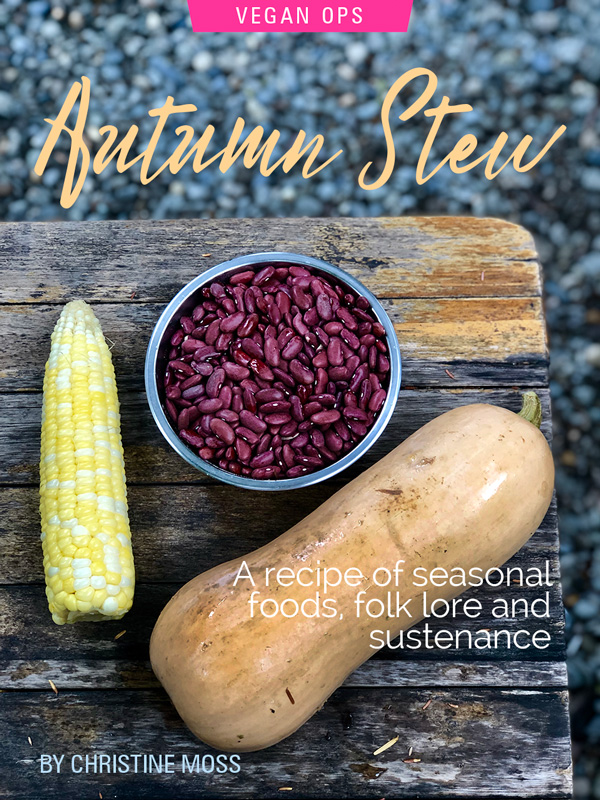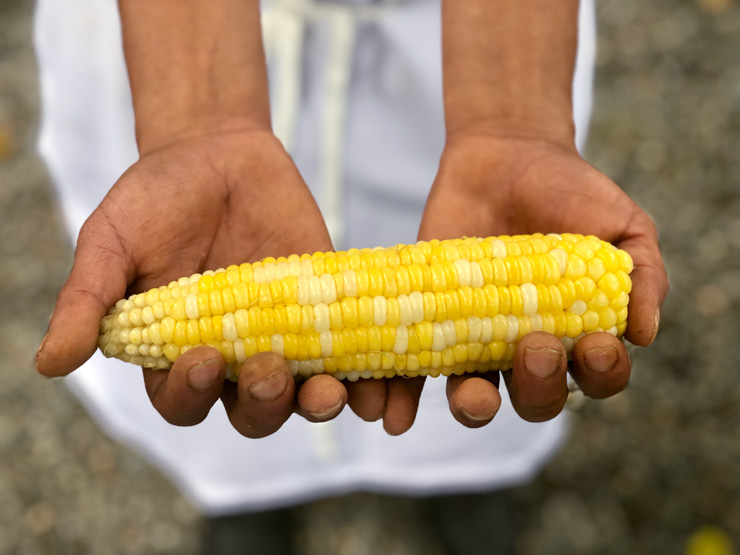
A hearty autumn stew whipped up with a side of folk lore and love — connecting us to the sustenance on our plates with a new appreciation
_
Autumn is by far, my favorite time of year to eat. The warm sunlit days and chilly evenings stir a deep hunger within that is satiated by the abundance of amazing produce that is finally available. Not only is my belly happy, but all of my senses are in full joy mode. The colorful leaves are like stepping into a beautiful painting.
There is a faint hint of woodfire in the evening air. Warm, nutrient-dense foods keep our energy and spirits up. In this area of the Hudson Valley is a mountainous and forested region. The change from summer into autumn is magical. The history and lore of where we live is intertwined with the foods we are blessed to eat this time of year.
Though better known as the Iroquois, (a word used by the French) the Haudenosaunee perfected a style of growing that sustained not only the earth and the soil, but the health of the body as well.
I would like to respectfully honor their legend of the Three Sisters by sharing their story and a recipe that I hope will keep you full of warmth and joy as the days begin to get colder and the daylight shorter.
The legend of the ‘Three Sisters’ is widely spread across the Americas and this particular version is local to my region of upstate New York. A more detailed version can be found at The Three Sisters: Exploring an Iroquois Garden.
As the story goes, there were three sisters who lived in a field. The youngest, who was so little, could only crawl and was dressed in green. The second sister used to love to run off by herself in the warm sunshine and wore a bright yellow dress. The third sister, the eldest, stood straight and tall and always tried to protect her sisters. She wore a pale green shawl and had long silky, yellow hair that tossed about in the breezes. The three sisters loved each other and were always together.
One day a stranger came to the field, a young boy who made arrows. The three sisters were very curious about him. Soon after his appearance the youngest sister disappeared. The two sisters cried and mourned her absence. The stranger returned again and soon after that, the second sister disappeared too. Now the oldest was left all alone in the field. In despair, she cried every day. The young boy returned to the field and heard her cries. He felt badly and carried her back to his home where she was reunited with her two sisters.
They had been so curious about him that they followed him home. Winter was coming and they had decided to stay because it was warm and he needed their help. The littlest sister was by now more grown up and she helped keep the dinner pot full, the second sister sat on a shelf drying herself to be ready to fill the dinner pot later. The oldest sister joined them and helped by grinding meal. They were never separated again.
If you haven’t guessed yet, the little sister in green is the bean, the second sister is the squash and the oldest sister is the corn. Together, beans, squash and corn are the ‘sustainers of life’.
In the garden, the corn provides the ladder for the beans to grow upon and together they create shade for the squash to thrive. Most of the corn grown today goes to feed livestock or into industrial products. But as a food, it provides a foundation of complex carbohydrates; the beans provide protein, the squash provides vitamins and squash seeds provide healthy fat.

I believe that knowing and honoring where our food comes from adds a richer layer of flavor and nourishment that keeps us healthy — and connects us on a deeper level to appreciate what is on our plate — to understand true life sustenance.
Every child of today knows these sisters and needs them just as much as the little Indian boy did. For the little sister in green is the bean. Her sister in yellow is the squash, and the elder sister with long flowing hair of yellow and the green shawl is the corn.
~ A Mohawk legend
Cooking with dried beans
Dried beans have a beautiful texture both soft yet firm with tremendous flavor that cannot be compared to canned beans. It is well worth the extra step to cook with dried beans, plus dried beans are less expensive.
When buying dried beans, choose organic whenever possible. The difference in flavor (not to mention health benefits) is significant. Make sure to choose a package that looks fresh with mostly whole beans. Avoid dusty looking beans or packages with a lot of broken pieces. It’s best to purchase from bins in health stores.
Rinse dried beans very well to clean them of any dust and remove large particles of dirt or rocks (yes, rocks. It’s not uncommon to find them). Place in a bowl or pot and cover with a few inches of clean water. Cover and store in the refrigerator overnight.
Or, once your beans have been cleaned place them in a pot and cover with about 2 inches of water. The exact amount is not important. Bring the pot to a boil, cover and then turn off the heat. Let it soak for at least half an hour up to 3 or 4 hours.
Once your beans have soaked using either method, pour off the soaking water and rinse the beans. Put them into a large pot and cover with a few inches of clean water. On a medium heat bring the beans up to a simmer, but don’t let them boil (boiling causes them to break apart). At this point, add in a small piece of kombu, wakame or dulse seaweed to the beans to aid in digestion.
Important, do not add salt yet. Salt inhibits the beans from softening at this stage and it won’t matter how long you cook them they will remain hard. Believe me, I have made this mistake!! It is sad after hours of cooking to have inedible beans.
Simmer for 1 to 2 hours until tender. As the water gets low, add in more to keep the beans submerged as they cook. You can also transfer them to a slow cooker at this point with all of your other ingredients and let it do its magic overnight or while you are out at work. Sauté your vegetables with the spices before adding to the slow cooker for even better flavor.
When cooking beans, as it is getting close to being done, taste the broth for flavor rather than the beans as it takes a very long time for the beans to soak up all of the flavors and it can be easy to over-salt your dish early on.
_
Red Bean and Butternut Squash Stew Served With Polenta

Ingredients:
- 2 cups dried red kidney beans prepared and simmered according to soaking directions above
- 4 stalks celery diced
- 2-3 small carrots washed and sliced
- 2-3 cloves garlic minced
- 1-2 small sweet potatoes peeled and cubed
- 1 Spanish onion diced
- 1 butternut squash peeled, cut into 1” cubes, seeds cleaned and reserved
- 2 Bay leaves
- 1 TBSP cumin
- 1 TBSP dried thyme
- 1 tsp black pepper
- 1 TBSP maple syrup
- Salt to taste
- 1-2 TBSP olive oil
Directions:
- Into a large heavy-bottomed pot sauté onions, celery and garlic for 3-4 minutes.
- Add in carrots and sweet potatoes. Sauté another 8-10 minutes.
- Add in butternut squash and about ½ tsp salt. Stir and reduce heat to low and cover. Cook for 10-12 minutes stirring occasionally.
- Remove lid, stir again add in prepared beans with all of their cooking liquid, bay leaves, cumin, black pepper and a little more salt. Stir and cover. Let simmer for 25-30 minutes stirring occasionally from the bottom so it doesn’t stick.
- Stir again and taste the broth. Add in more salt if needed and the maple syrup.
- Let it simmer slowly for another 20-30 minutes. The broth will thicken as it cooks.
- Shut off the heat and let it sit for 10 minutes before serving. It will taste even better the next day as the flavors meld together.

Polenta
Follow the directions on the package and add lots of vegan butter for a very creamy polenta. Or polenta can be purchased already prepared in the refrigerator section of your market. Slice into ½” slices and quickly pan fry in a little olive oil or vegan butter and serve on top of the stew.
Another option is to serve it with corn tortillas, cornbread or fresh corn on the cob.
You may enjoy these other vegan recipes from Chef Christine Moss on her Author Page.